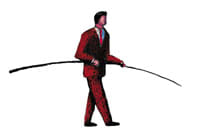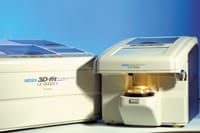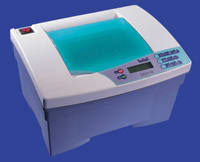
A walk through new products and market trends that are helping
practitioners stay a step ahead through in-office lens edging
By Susan P. Tarrant
|
|
|
|
Delta-Scan® 3D Tracer from AIT Industries |
|
We've been hearing about it and reading it about everywhere we turn--the American economy is experiencing a "downturn," or a "recession," or is "tight," or is just plain "slow." Whatever you call it and whatever is really happening, a simple result is that many people are thinking twice before spending their dollars. And that has translated into a leveling off of activity in many segments of our industry.
How, then, can one infuse an optical outlet with new business, new life? For many independent practitioners, offering expanded services such as same-day or next-day lenses has been a way to stay competitive against the growing number of giant chains and super opticals.
"The practices that are really going to do well are those that can differentiate themselves from their competition. The way to do that is through quality of service, and that means speed of turnaround as well as quality of lens," says Tim Aiken, vice president of sales for Briot-Weco. "You've got to create more excitement in your business, and take more opportunities to expand your services."
Chief among those opportunities is setting up or upgrading an in-office lab, in which you can take semi-finished lenses and edge them yourself. It is, according to some of the industry's equipment leaders, a safe way to increase business even in an economy that some are describing as anything but.
|
|
|
|
The LEXES (LENS EXPRESS finishing system) from Santinelli International |
VENDOR VIEWS
"People are thinking, even in a tenuous environment, 'what can I do to enhance business that's time-tested and true?' The answer is edging," says Steve Swalgen, director of sales for Santinelli International. "People understand the advantages of in-office edging. It's been out there, it's proven. It's not a matter of being conservative, it's a matter of mitigating risk."
And, because the edging technology continues to get more automated, practitioners don't need to hire specially skilled operators--existing office staff or doctors and opticians can handle most edging jobs themselves.
So, many from the equipment sector report that even though small business owners may be cautious in their financial moves, practitioners are turning to edging as a way to better equip themselves to make it through the tough times.
"They're thinking, 'If I bring edging in-house, I don't have to bring someone new in to run it. The technology is proven, and it's money in my pocket instead of in the lab's pocket. Plus, I can now compete better by offering one-day service,'" Swalgen states.

It's all part of a changing attitude among independents. "I think lots of people have stopped relying on the stock market to make their money and are focusing on making all their money from their business," says Vulich.
Additionally, smart practitioners are taking advantage of the financial incentives that have been implemented to encourage businesses to make investments in new equipment.
"Everyone is offering incentives, from the government with tax incentives, to the lenders with their interest rates, to the individual companies with their special pricing. Now is a great time to get started," says Briot-Weco's Aiken.
Indeed, in tenuous economic times it is imperative for ECPs to be constantly reassessing their needs and their business plans, says Susan Polson of National Optronics. She agrees that practitioners should be looking at the feasibility of bringing their lens finishing in-house, and adds another great reason to consider it.
"Personnel is always such a big issue in every decision practitioners make, including whether or not they should bring edging work in-house," she says. And if yours is a situation in which you'll have to hire someone to work your edging lab, "one thing to consider is that perhaps these economic times have created a larger pool of qualified, smart, employable people" from which to draw.
|
|
|
|
The Sigma™ Tracer from Gerber Coburn |
|
HIGH-END OR VALUE PACKAGE?
Practitioners who are looking to install or upgrade an edging lab in their business are looking at more choices than ever before--not only in technology and features in the equipment, but in pricepoints as well.
Responding to practitioners' varying abilities to make capital investments or take on leases, several equipment companies have introduced machines that are designed for the more budget-oriented customer, offering slightly fewer features while retaining accuracy and ease-of-use elements.
"I think people want the bells and whistles, but they also want tiered pricing," Swalgen of Santinelli says. As a result, manufacturers are beginning to offer a broader array of technology options and a broader array of price points. "As long as the quality is offered, manufacturers can adjust features to appeal to everyone."
Bill Galindo, vice president of sales and marketing at ODI/Topcon, says that his business has seen huge growth in sales of refurbished equipment, as ECPs look for ways to bring edging in-house at a low cost.
"You could buy a second-hand patternless edger for around $11,000," Galindo says. "Of course, it may not have as many features as you want, but it will be able to turn out a quality product."
He adds that people opting for new equipment over the refurbished models often do so because "the new frame styles coming out may not fit as well in the older machines. Also, the B measurements are much more narrow now."
Yet not everyone sees wisdom in the decision to go the budget route. "I don't believe that you don't need all that extra stuff," says Briot-Weco's Aiken. "It's a long-term investment, so you've got to look long-term."
|
|
|
|
Topcon's Ultima 5000 lens finishing system |
|
According to Marc Okrant, group product manager for Gerber Coburn, the buying behavior witnessed by his company is trending more toward higher technology than low-cost equipment. One of the major advantages of the higher-tech models is that they do not require skilled labor to run them.
Higher-tech equipment also allows practitioners to become more efficient in their operations and frees up their time to concentrate on other business matters rather than lab management.
In fact, Okrant says, "an increasing trend today is that some doctors are opting to install not only finishing labs, but full-service labs as a means of capturing a larger portion of the value chain and of providing an increased level of service to their customers."
NEW IN EDGING
Whether you're looking to upgrade your existing lab equipment, or considering setting up an in-office edging lab for the first time, there will be plenty to choose from at International Vision Expo East. Though we only have space here for one new product per company, several vendors are introducing more than one at Expo, so be sure to ask what else is new:
AIT INDUSTRIES: In response to customers looking for a less expensive way to do remote tracing without sacrificing accuracy, AIT Industries has released the Delta-Scan® 3D Tracer. The benefits of the tracer include the ability to interface with a host lab server under the OMA/VCA communication standard, plus it can act as an OMA host for all AIT edgers as a direct connection with its own storage capacity.
For more information, call 800-729-1959, or visit www.aitindustries.com
BRIOT: Briot USA has introduced its new Scanform Net 2 remote tracer, which features the company's "5-D" (size, shape, curvature, thickness, and the eyewire bevel angle) tracing technology and fully automatic loading. The tracer measures each frame side separately using a double stylus tracing system designed to simulate lens fit inside the frame, resulting in an accurate fit as well as the optimum aesthetic placement of the lens inside the frame for the best cosmetic appearance. The automatic loading feature allows operators to simply drop the frame into the tracer and let go: The machine positions and traces the frame, then relays all measurements and patient job data to the practitioner's lab.
For more information, call 800-292-7468, or visit www.briotusa.com
GERBER COBURN: Late in 2002, Gerber Coburn rolled out its Sigma™, a simple, compact edging system with 4-D processing technology, traditional blocking functions, and a user-friendly interface--a system, the company says, that is ideal for first-time users integrating finishing equipment into their practices.
The new 4-D Sigma Tracer measures x, y, and z, and provides the frame groove angle as well, improving process time required for acquiring the profile of the frame wire groove and making the lens-to-frame fit more precise, the company reports. Its integrated blocking station, located within the bounds of the edger to save workspace and operator movements, has computerized layout targets that simplify the blocking process and a color reversal function that makes it possible to visualize characteristics of difficult lenses.
The system employs the OMA/VCA communications protocol, and its components can interface with lab layout systems (including Gerber Coburn's Innovations Software), allowing for easy expansion when the practitioner is ready.
For more information, call 800-843-1479, or visit www.gerbercoburn.com
|
|
|
|
National Optronics' LP Lens Profiler |
|
NATIONAL OPTRONICS: The LP Lens Profiler is the latest addition to National Optronics' lens processing equipment line. Designed to enhance the remote entry process for frame-to-follow jobs, as well as to allow better surfacing of uncuts, the LP is an affordable alternative to a full-featured tracer. The LP provides far more accurate sizing than the hand tracings and estimates of frame tapes that retailers often send to labs to approximate the correct dimensions of lenses.
The LP works through the operator, creating a manual trace of the lens or pattern with a high-resolution digital pad using an electronic stylus. The resulting trace can be attached directly to remote entry orders created through third-party software remote packages and/or Vision Web. The LP will allow the labs to give their customers options when considering remote-site or Internet-based ordering.
For more information, call 800-247-9796, or visit www.nationaloptronics.com
SANTINELLI INTERNATIONAL: Santinelli International announces its LEXES, providing eyecare professionals with fully integrated, automated tracing, blocking, and edging in one seamless finishing system. LEXES, an acronym for LENS EXPRESS edging system, has a new high-speed, direct-drive motor, providing 30 percent faster edging and fully automated safety beveling, grooving, and polishing.
Santinelli's top-of-the-line LEXES boasts a Super Intelligent tracer/blocker, which automatically identifies single vision, bifocals, and progressive lenses, making the blocking process faster and easier. The system's tracer digitizes 32,000 points of reference per eye. In addition, LEXES' precise blocking head rotates automatically to find the decentered blocking point without the need for a lens meter. Utilizing advanced Auto Lens Meter (ALM) function and multi-axis rotational blocking, LEXES quickly identifies the optical center and axis. Lenses are blocked automatically, perfectly decentered with the required axis correction ready to edge.
The LEXES dual-unit system is a combination tracer/blocker and edger. This delineation allows for continual job processing, yielding maximum throughput in an abbreviated amount of time. The operator need only press the start button. All operational conditions, reports the company, have been pre-programmed for perfect fitting, finished lenses.
For more information, call 800-435-EDGE, or visit www.santinelli.com
|
|
|
|
Scanform Net 2 remote tracer from Briot USA |
TOPCON/ODI: Topcon/ODI has released its new ULTIMA 5000 Lens Finishing System. This new multi-task system incorporates user-friendly equipment for today's value-conscious optical proprietor. The system features all-material edging, a large color LCD screen, Topcon's precision 3D frame tracing, safety beveling, safety beveling polishing, grooving and DIAMOND-LUSTER™ polishing.
Topcon's Windows®-format operating system allows for easy processing of all present and future lens materials. The optional DS-5000 Integrated Blocker automatically displays the correct blocking position for all types of lenses. The system is OMA/VCA compliant, allowing it to integrate easily with other laboratory equipment.
For more information, call 800-223-1130, or visit www.topcon.com
WECO USA: The new WECO Verifier Pro is a high-speed automatic lens verification and blocking device that completes layout and blocking in an average of just 40 seconds per lens, which makes it ideal for chains and high-volume, multiple-office locations. It automatically analyzes most lens types, including single vision, bifocal, and printed progressive lenses, and identifies the optical center automatically. The device eliminates the need for the operator to use a lensmeter to mark the lens, which speeds up processing time and reduces the skill level required for the lab's finish blocking station. The WECO Verifier Pro provides precise axis positioning and exceeds ANSI standards for lens-meters within the specified lens range. Its smart automation alerts the operator if parameters are outside the recommended tolerances to avoid errors.
For more information, call 877-872-9326, or visit www.usaweco.com
|
Buying Tips |
Shopping for edging equipment? With all the advanced technology and variety of equipment offered now, we asked our experts for some tips to help you make your decisions. Plan. Choose equipment that fits your plans for today and tomorrow. Start with a base system that will expand to where you want to be three to five years from now. References. Go with a company you can trust. Ask for references, and compare companies based on their technical support and service. Open mind. Keep an open mind and investigate a variety of systems. Don't base your decision based solely on price--evaluate the ease of use, quality of the finished product, ergonomics, and accuracy. Cosmetics. Be aware that it's the cosmetics of the lens that is driving the consumer as much as the style of the frame. Closely examine the quality of the finish of the lens after it comes out of the machine. "He who has the best finish and polish is going to get noticed first," says Steve Swalgen of Santinelli International. Warranty. If buying a refurbished model, be mindful of the warranty, as well as its length and breadth of coverage. |
|
Alternatives To Traditional Edging |
While edging equipment may be what's in the majority of in-office optical labs, a look at retail finishing equipment wouldn't be complete without a mention of the other alternatives. Brian Cullather, vice president of marketing for Optical Dynamics, says his company's lens casting system is gaining the interest of practitioners who are looking to reduce even further their cost of goods and services. The system casts lenses from a monomer to the patient's exact prescription, rather than grinding an existing lens blank. The advantages, he says, are a "pristine" lens surface and freedom from having to buy lens blanks. Offices wishing to do their own lens surfacing rather than relying on wholesale labs may look toward the FastGrind system, which uses pre-blocked brand-name blanks and surfaces them to a patient's Rx. The system needs only a five square foot footprint. The system is a great way to offer multi-focals with same-day turnaround service. Another option is NexGen Vision, Inc.'s lens casting system, which allows labs and retail chains to cast single vision, flat-tops, and PALs to prescription in less than 10 minutes. Thanks to an agreement with Corning Optical, NexGen users will also be able to cast SunSensors photochromic lenses. |









